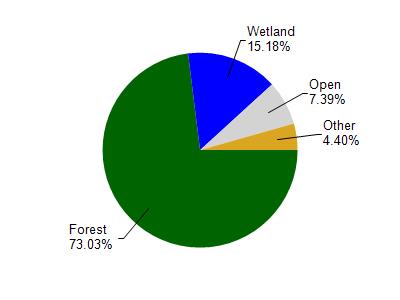Burnett, Washburn
No
Yes
No
Fish and Aquatic Life
Overview
Big Mckenzie Lake, in the Lower Namekagon River Watershed, is a 1,128.95 acre lake that falls in Burnett and Washburn Counties. This lake is an outstanding/exceptional resource water under NR102 under the Fisheries Program. This lake is managed for fishing and swimming and is currently considered impaired.
Date 2015
Author Aquatic Biologist
Historical Description
Big McKenzie Lake is a 1185 acre drainage lake located on the Burnett - Washburn County
line. This high quality lake has been nominated for the "Outstanding Resource Water"
designation. Intensive water quality monitoring has been conducted on this lake since 1986 as a
part of the Department's long term trend monitoring program. An active lake association is
present on this lake and a member is monitoring water clarity and lake levels as a part of the
self-help monitoring program. Big McKenzie Lake has an excellent and diverse fishery including
muskellunge and walleye as well as a remnant population of lake sturgeon and cisco.
This ORW nominated lake and the other two lakes in the "McKenzie chain" should be accorded
a high priority for selection as a Priority Lakes project.
Date 1992
Author Surface Water Inventory Of Wisconsin
General Condition
Big Mckenzie Lake (WBIC 2706800) was placed on the impaired waters list for excess algal growth in 2014. This water was assessed during the 2018 listing cycle; new total phosphorus and chlorophyll-a sample data were clearly below the 2018 WisCALM listing thresholds for the Recreation use and the Fish and Aquatic Life use. This water was meeting these designated uses and was not considered impaired. This water was proposed for delisting in 2018.
Date 2017
Author Ashley Beranek
Impaired Waters
Big Mckenzie Lake (2706800) was placed on the impaired waters list for excess algal growth in 2014. The 2016 assessments showed continued excess algal growth; chlorophyll sample data exceed 2016 WisCALM listing thresholds for the Recreation use, however, total phosphorus data do not exceed REC thresholds. Total phosphorus and chlorophyll data were clearly below Fish and Aquatic Life listing thresholds. Based on the most updated information, no change in existing impaired waters listing is needed.
Date 2015
Author Aaron Larson
Condition
Wisconsin has over 84,000 miles of streams, 15,000 lakes and milllions of acres of wetlands. Assessing the condition of this vast amount of water is challenging. The state's water monitoring program uses a media-based, cross-program approach to analyze water condition. An updated monitoring strategy (2015-2020) is now available. Compliance with Clean Water Act fishable, swimmable standards are located in the Executive Summary of Water Condition in 2018. See also the 'monitoring and projects' tab.
Reports
Management Goals
Wisconsin's Water Quality Standards provide qualitative and quantitative goals for waters that are protective of Fishable, Swimmable conditions [Learn more]. Waters that do not meet water quality standards are considered impaired and restoration actions are planned and carried out until the water is once again fishable and swimmable
Management goals can include creation or implementation of a Total Maximum Daily Load analysis, a Nine Key Element Plan, or other restoration work, education and outreach and more. If specific recommendations exist for this water, they will be displayed below online.
Monitoring
Monitoring the condition of a river, stream, or lake includes gathering physical, chemical, biological, and habitat data. Comprehensive studies often gather all these parameters in great detail, while lighter assessment events will involve sampling physical, chemical and biological data such as macroinvertebrates. Aquatic macroinvertebrates and fish communities integrate watershed or catchment condition, providing great insight into overall ecosystem health. Chemical and habitat parameters tell researchers more about human induced problems including contaminated runoff, point source dischargers, or habitat issues that foster or limit the potential of aquatic communities to thrive in a given area. Wisconsin's Water Monitoring Strategy was recenty updated.
Grants and Management Projects
Monitoring Projects
| WBIC | Official Waterbody Name | Station ID | Station Name | Earliest Fieldwork Date | Latest Fieldwork Date | View Station | View Data |
|---|
| 2706800 | McKenzie Lake | 10018216 | Big McKenzie Lake -- Access | 8/8/2007 | 9/8/2024 | Map | Data |
| 2706800 | McKenzie Lake | 073148 | Big Mckenzie Lake - Deep Spot-Burnett Co | | | Map | Data |
| 2706800 | McKenzie Lake | 073152 | Big Mckenzie Lake - Deep Spot | | | Map | Data |
| 2706800 | McKenzie Lake | 663129 | Big McKenzie Lake - Deep Hole | 5/10/1986 | 8/28/2025 | Map | Data |
| 2706800 | McKenzie Lake | 10001039 | Big McKenzie Lake | 4/19/1997 | 5/6/2023 | Map | Data |
| 2706800 | McKenzie Lake | 073103 | Big Mckenzie Lake - South Basin | 6/24/1997 | 8/21/1998 | Map | Data |
| 2706800 | McKenzie Lake | 073102 | Big Mckenzie Lake - North Basin | 6/24/1997 | 8/21/1998 | Map | Data |
|

Watershed Characteristics
McKenzie Lake is located in the Lower Namekagon River watershed which is 239.34 mi². Land use in the watershed is primarily forest (73.10%), wetland (15.20%) and a mix of open (7.40%) and other uses (4.40%). This watershed has 172.53 stream miles, 12,590.30 lake acres and 21,781.64 wetland acres.
Nonpoint Source Characteristics
This watershed is ranked Not Ranked for runoff impacts on streams, Not Ranked for runoff impacts on lakes and Low for runoff impacts on groundwater and therefore has an overall rank of Low. This value can be used in ranking the watershed or individual waterbodies for grant funding under state and county programs.This water is ranked High Lake for individual Lakes based on runoff problems and the likelihood of success from project implementation.